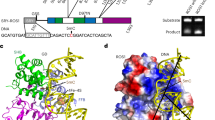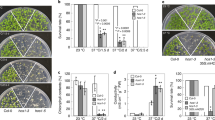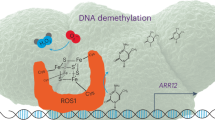Abstract
The active DNA demethylase Repressor of Silencing 1 (ROS1) regulates genomic DNA methylation patterns during plant development. ROS1 expression is promoted by DNA methylation within its promoter region. However, the mechanisms and biological significance of ROS1 regulation under abiotic stresses remain elusive. Here we show that heat stress reduces DNA methylation in the ROS1 promoter to suppress its expression. Under normal conditions, SUVH1 and SUVH3 bind methylated ROS1 promoter regions, inhibiting chromatin interactions around the ROS1 locus; heat stress triggers their dissociation, enabling chromatin loop formation to suppress ROS1 transcription. Transgenic plants with exogenous ROS1 maintain high expression levels during heat stress, causing transposable element hypomethylation and enhanced transcription and transgenerational transposition of the heat-activated retrotransposon ONSEN. We propose that heat-induced suppression of ROS1 transcription, which is conserved across plant species, serves as a brake system to limit transposable element activation, thereby safeguarding genome stability.
This is a preview of subscription content, access via your institution
Access options
Access Nature and 54 other Nature Portfolio journals
Get Nature+, our best-value online-access subscription
$32.99 / 30 days
cancel any time
Subscribe to this journal
Receive 12 digital issues and online access to articles
$119.00 per year
only $9.92 per issue
Buy this article
- Purchase on SpringerLink
- Instant access to full article PDF
Prices may be subject to local taxes which are calculated during checkout






Similar content being viewed by others
Data availability
RNA-seq data of Col-0 under normal, heat stress and recovery conditions were previously deposited in Gene Expression Omnibus under accession number GSE132415. Hi-C data of Col-0 under normal and heat stress conditions were previously deposited in the National Center for Biotechnology Information Sequence Read Archive under accession number PRJNA545383. Methylome data (Col-0 under normal condition; Col-0, ros1-4 and SP:ROS1-GFP under heat stress) and ATAC-seq data (Col-0 under control versus heat stress) have been submitted to the China National Center for Bioinformation under accession number PRJCA036954 (the link for WGBS data is https://ngdc.cncb.ac.cn/gsa/s/UTraPW9M; the link for ATAC-seq data is https://ngdc.cncb.ac.cn/gsa/s/h6dC68Mx). All other supporting data are included in the article or its Supplementary Information. Source data are provided with this paper.
References
Law, J. A. & Jacobsen, S. E. Establishing, maintaining and modifying DNA methylation patterns in plants and animals. Nat. Rev. Genet. 11, 204–220 (2010).
Reik, W., Dean, W. & Walter, J. Epigenetic reprogramming in mammalian development. Science 293, 1089–1093 (2001).
Zhang, H. M., Lang, Z. B. & Zhu, J. K. Dynamics and function of DNA methylation in plants. Nat. Rev. Mol. Cell Biol. 19, 489–506 (2018).
Henderson, I. R. & Jacobsen, S. E. Epigenetic inheritance in plants. Nature 447, 418–424 (2007).
Jing, Y. Q. et al. SUVH2 and SUVH9 couple two essential steps for transcriptional gene silencing in Arabidopsis. Mol. Plant 9, 1156–1167 (2016).
Lister, R. et al. Highly integrated single-base resolution maps of the epigenome in Arabidopsis. Cell 133, 523–536 (2008).
Zhang, H. M. & Zhu, J. K. RNA-directed DNA methylation. Curr. Opin. Plant Biol. 14, 142–147 (2011).
Matzke, M. A. & Mosher, R. A. RNA-directed DNA methylation: an epigenetic pathway of increasing complexity. Nat. Rev. Genet. 15, 394–408 (2014).
Stroud, H. et al. Non-CG methylation patterns shape the epigenetic landscape in Arabidopsis. Nat. Struct. Mol. Biol. 21, 64–72 (2014).
Zemach, A. et al. The Arabidopsis nucleosome remodeler DDM1 allows DNA methyltransferases to access H1-containing heterochromatin. Cell 153, 193–205 (2013).
Gong, Z. H. et al. ROS1, a repressor of transcriptional gene silencing in Arabidopsis, encodes a DNA glycosylase/lyase. Cell 111, 803–814 (2002).
Williams, B. P., Pignatta, D., Henikoff, S. & Gehring, M. Methylation-sensitive expression of a DNA demethylase gene serves as an epigenetic rheostat. PLoS Genet. 11, e1005142 (2015).
Lei, M. et al. Regulatory link between DNA methylation and active demethylation in Arabidopsis. Proc. Natl Acad. Sci. USA 112, 3553–3557 (2015).
Harris, C. J. et al. A DNA methylation reader complex that enhances gene transcription. Science 362, 1182–1186 (2018).
Xiao, X. L. et al. A group of SUVH methyl-DNA binding proteins regulate expression of the DNA demethylase ROS1 in Arabidopsis. J. Integr. Plant Biol. 61, 110–119 (2019).
Zhao, Q. Q., Lin, R. N., Li, L., Chen, S. & He, X. J. A methylated-DNA-binding complex required for plant development mediates transcriptional activation of promoter methylated genes. J. Integr. Plant Biol. 61, 120–139 (2019).
Liu, J. Z., Feng, L. L., Li, J. M. & He, Z. H. Genetic and epigenetic control of plant heat responses. Front. Plant Sci. 6, 267 (2015).
Perrella, G., Bäurle, I. & van Zanten, M. Epigenetic regulation of thermomorphogenesis and heat stress tolerance. New Phytol. 234, 1144–1160 (2022).
Torres, J. R. & Sanchez, D. H. Emerging roles of plant transcriptional gene silencing under heat. Plant J. 119, 1197–1209 (2024).
Ito, H. et al. An siRNA pathway prevents transgenerational retrotransposition in plants subjected to stress. Nature 472, 115–119 (2011).
Sun, L. H. et al. Heat stress-induced transposon activation correlates with 3D chromatin organization rearrangement in Arabidopsis. Nat. Commun. 11, 1886 (2020).
Cavrak, V. V. et al. How a retrotransposon exploits the plant’s heat stress response for its activation. PLoS Genet. 10, e1004115 (2014).
Williams, B. & Gehring, M. Stable transgenerational epigenetic inheritance requires a DNA methylation-sensing circuit. Nat. Commun. 8, 2124 (2017).
He, L. et al. Pathway conversion enables a double-lock mechanism to maintain DNA methylation and genome stability. Proc. Natl Acad. Sci. USA 118, e2107320118 (2021).
Erdmann, R. M. & Picard, C. L. RNA-directed DNA methylation. PLoS Genet. 16, e1009034 (2020).
Nozawa, K. et al. DNA methyltransferase CHROMOMETHYLASE 3 prevents ONSEN transposon silencing under heat stress. PLoS Genet. 17, e1009710 (2021).
Liu, C. et al. Genome-wide analysis of chromatin packing in Arabidopsis thaliana at single-gene resolution. Genome Res. 26, 1057–1068 (2016).
Wang, X. K. et al. The cytosolic Fe-S cluster assembly component MET18 is required for the full enzymatic activity of ROS1 in active DNA demethylation. Sci. Rep. 6, 26443 (2016).
Zhu, J. H., Kapoor, A., Sridhar, V. V., Agius, F. & Zhu, J. K. The DNA glycosylase/lyase ROS1 functions in pruning DNA methylation patterns in Arabidopsis. Curr. Biol. 17, 54–59 (2007).
Wang, L. C. et al. Arabidopsis HIT4 encodes a novel chromocentre-localized protein involved in the heat reactivation of transcriptionally silent loci and is essential for heat tolerance in plants. J. Exp. Bot. 64, 1689–1701 (2013).
Lee, S. C. & Martienssen, R. A. Regulation of retrotransposition in Arabidopsis. Biochem. Soc. Trans. 49, 2241–2251 (2021).
Zhang, P. P. et al. Extrachromosomal circular DNA and structural variants highlight genome instability in Arabidopsis epigenetic mutants. Nat. Commun. 14, 5236 (2023).
Zhang, H., Gong, Z. Z. & Zhu, J. K. Active DNA demethylation in plants: 20 years of discovery and beyond. J. Integr. Plant Biol. 64, 2217–2239 (2022).
Liang, Z. et al. Reorganization of the 3D chromatin architecture of rice genomes during heat stress. BMC Biol. 19, 53 (2021).
Yang, F. F. et al. Plant-specific histone deacetylases associate with ARGONAUTE4 to promote heterochromatin stabilization and plant heat tolerance. New Phytol. 238, 252–269 (2023).
Lang, Z. B. et al. Critical roles of DNA demethylation in the activation of ripening-induced genes and inhibition of ripening-repressed genes in tomato fruit. Proc. Natl Acad. Sci. USA 114, E4511–E4519 (2017).
Folsom, J. J., Begcy, K., Hao, X. J., Wang, D. & Walia, H. Rice Fertilization-Independent Endosperm1 regulates seed size under heat stress by controlling early endosperm development. Plant Physiol. 165, 238–248 (2014).
Hossain, M. S. et al. Divergent cytosine DNA methylation patterns in single-cell, soybean root hairs. New Phytol. 214, 808–819 (2017).
Ma, Y. Z. et al. Disrupted genome methylation in response to high temperature has distinct affects on microspore abortion and anther indehiscence. Plant Cell 30, 1387–1403 (2018).
López, M. E., Roquis, D., Becker, C., Denoyes, B. & Bucher, E. DNA methylation dynamics during stress response in woodland strawberry (Fragaria vesca). Hortic. Res. 9, uhac174 (2022).
Gao, G. Z. et al. Comparison of the heat stress induced variations in DNA methylation between heat-tolerant and heat-sensitive rapeseed seedlings. Breed. Sci. 64, 125–133 (2014).
Li, J. et al. Global DNA methylation variations after short-term heat shock treatment in cultured microspores of Brassica napus cv Topas. Sci. Rep. 6, 38401 (2016).
Qin, W. Q. et al. Activation tagging identifies WRKY14 as a repressor of plant thermomorphogenesis in Arabidopsis. Mol. Plant 15, 1725–1743 (2022).
Seo, P. J. et al. A self-regulatory circuit of CIRCADIAN CLOCK-ASSOCIATED1 underlies the circadian clock regulation of temperature responses in Arabidopsis. Plant Cell 24, 2427–2442 (2012).
Wang, H. R. et al. Thermosensitive SUMOylation of TaHsfA1 defines a dynamic ON/OFF molecular switch for the heat stress response in wheat. Plant Cell 35, 3889–3910 (2023).
Zeng, J. et al. Nitric oxide controls shoot meristem activity via regulation of DNA methylation. Nat. Commun. 14, 8001 (2023).
Zhang, Z. Y. et al. OsMAPK3 phosphorylates OsbHLH002/OsICE1 and inhibits its ubiquitination to activate OsTPP1 and enhances rice chilling tolerance. Dev. Cell 43, 731–743 (2017).
La, H. G. et al. A 5-methylcytosine DNA glycosylase/lyase demethylates the retrotransposon Tos17 and promotes its transposition in rice. Proc. Natl Acad. Sci. USA 108, 15498–15503 (2011).
Hayashi, Y. et al. ONSEN shows different transposition activities in RdDM pathway mutants. Genes Genet. Syst. 95, 183–190 (2020).
Akakpo, R., Carpentier, M. C., Ie Hsing, Y. & Panaud, O. The impact of transposable elements on the structure, evolution and function of the rice genome. New Phytol. 226, 44–49 (2020).
Bourque, G. et al. Ten things you should know about transposable elements. Genome Biol. 19, 199 (2018).
Roquis, D. et al. Genomic impact of stress-induced transposable element mobility in Arabidopsis. Nucleic Acids Res. 49, 10431–10447 (2021).
Huang, T. X. et al. Evolution of lmiRNAs and their targets from MITEs for rice adaptation. J. Integr. Plant Biol. 64, 2411–2424 (2022).
Li, J., Wang, Z., Peng, H. & Liu, Z. A MITE insertion into the 3′-UTR regulates the transcription of TaHSP16.9 in common wheat. Crop J. 2, 381–387 (2014).
Shen, J. Q. et al. Translational repression by a miniature inverted-repeat transposable element in the 3′ untranslated region. Nat. Commun. 8, 14651 (2017).
Venkatesh & Nandini, B. Miniature inverted-repeat transposable elements (MITEs), derived insertional polymorphism as a tool of marker systems for molecular plant breeding. Mol. Biol. Rep. 47, 3155–3167 (2020).
Zhang, H. T. et al. Transposon-derived small RNA is responsible for modified function of WRKY45 locus. Nat. Plants 2, 16016 (2016).
Zervudacki, J. et al. Transcriptional control and exploitation of an immune-responsive family of plant retrotransposons. EMBO J. 37, e98482 (2018).
Baduel, P. et al. Genetic and environmental modulation of transposition shapes the evolutionary potential of Arabidopsis thaliana. Genome Biol. 22, 138 (2021).
Lisch, D. How important are transposons for plant evolution? Nat. Rev. Genet. 14, 49–61 (2013).
Ye, R. Q. et al. Cytoplasmic assembly and selective nuclear import of Arabidopsis ARGONAUTE4/siRNA complexes. Mol. Cell 46, 859–870 (2012).
Louwers, M., Splinter, E., van Driel, R., de Laat, W. & Stam, M. Studying physical chromatin interactions in plants using Chromosome Conformation Capture (3C). Nat. Protoc. 4, 1216–1229 (2009).
Wang, X. K., Chen, X. D., Sun, L. H. & Qian, W. Q. Canonical cytosolic iron-sulfur cluster assembly and non-canonical functions of DRE2 in Arabidopsis. PLoS Genet. 15, e1008094 (2019).
Yuan, W. et al. ALBA protein complex reads genic R-loops to maintain genome stability in Arabidopsis. Sci. Adv. 5, eaav9040 (2019).
Liang, W. J. et al. Deciphering the synergistic and redundant roles of CG and non-CG DNA methylation in plant development and transposable element silencing. New Phytol. 233, 722–737 (2022).
Lin, W. et al. Active DNA demethylation regulates tracheary element differentiation in Arabidopsis. Sci. Adv. 6, eaaz2963 (2020).
Yin, X. C. et al. H2AK121ub in Arabidopsis associates with a less accessible chromatin state at transcriptional regulation hotspots. Nat. Commun. 12, 315 (2021).
Acknowledgements
We thank S. Jacobson for providing seeds of the suvh1 suvh3 mutant. This study was supported by the National Natural Science Foundation of China (32170285 to L.-M.F. and 32270288 to W.Q.) and Beijing Life Science Academy (BLSA: 2024500CA0010 to W.Q.).
Author information
Authors and Affiliations
Contributions
L.F., L.-M.F. and W.Q. designed the research; L.F., Y.J. and X.L. performed the experiments and analysed the data; W.Z., Y.M. and L.S. performed the bioinformatics analysis. L.F. drafted the paper; L.-M.F. and W.Q. revised the paper.
Corresponding author
Ethics declarations
Competing interests
The authors declare no competing interests.
Peer review
Peer review information
Nature Plants thanks Hidetaka Ito and the other, anonymous, reviewer(s) for their contribution to the peer review of this work.
Additional information
Publisher’s note Springer Nature remains neutral with regard to jurisdictional claims in published maps and institutional affiliations.
Extended data
Extended Data Fig. 1 ROS1 expression levels in the relative epigenetic mutants.
a, Quantification of ROS1 expression levels in Col-0, nrpd1-3, and nrpe1-11 under control and heat-stress conditions. Data represent mean ± s.d., n = 3 biological replicates. Two-tailed student’s t-test. b, Bisulfite sequencing data showing DNA methylation levels in the ROS1 MEMS region in rdd-2 under control and heat-stress conditions. At least 20 clones were sequenced for each sample. Each circle represents one biological replicate (n = 2 biological replicates). c, Quantification of ROS1 expression levels in Col-0, ros1-4, and rdd-2 under control and heat conditions. Data represent mean ± s.d., n = 3 biological replicates. Two-tailed student’s t-test.
Extended Data Fig. 2 Heat stress selectively targets the enROS1 locus rather than the exROS1 locus.
a, Quantification of total ROS1 transcript levels in Col-0 and NP:ROS1-LUC (ProROS1:ROS1-LUC/Col-0) transgenic lines. Data represent mean ± s.d., n = 3 biological replicates. Two-tailed Student’s t-test. b, Quantification of total ROS1 transcript levels in Col-0 and NP:ROS1-Myc (ProROS1:ROS1-Myc/Col-0) transgenic lines. Data represent mean ± s.d., n = 3 biological replicates. Two-tailed Student’s t-test. c, Quantification of enROS1 (left panel) and exROS1 (right panel) transcript levels in NP:ROS1-Myc transgenic lines under control and heat conditions. Data represent mean ± s.d., n = 3 biological replicates. Two-tailed Student’s t-test. d, Relative quantification of ROS1 transcript levels in Col-0 and SP:ROS1-GFP (super1300:ROS1-GFP/ros1-4) transgenic plants under control and heat-stress conditions. Data represent mean ± s.d., n = 3 biological replicates. Two-tailed Student’s t-test. e, Snapshots in the integrated Genome Browser (IGV) showing the ATAC-seq peak at the promoter of ROS1 (AT2G36490) in Col-0 under control (22 °C) and heat (37 °C) conditions.
Extended Data Fig. 3 SUVH1 binds DNA methylation in the ROS1 promoter and promotes ROS1 expression.
a, ChIP-qPCR assay analyzing the binding of SUVH1 at the ROS1 locus. The upper schematic illustrates the positions of primers (P1 - P3), and the lower column chart depicts the enrichment of SUVH1 at the ROS1 locus. Data represent mean ± s.d., n = 3 biological replicates. Two-tailed Student’s t-test. b, Quantification of SUVH1 transcript levels in Col-0 and SUVH1-Flag transgenic plants under control and heat-stress conditions. Data represent mean ± s.d., n = 3 biological replicates. Two-tailed Student’s t-test. c, Western blot analysis showing protein levels of SUVH1 under control (C) and heat-stress (H) conditions. ACTIN protein was used as the loading control. d, Quantification of ROS1 transcript levels in Col-0 and suvh1 suvh3 under control and heat-stress conditions. Data represent mean ± s.d., n = 3 biological replicates. Two-way ANOVA with Bonferroni’s multiple comparisons test.
Extended Data Fig. 4 Overexpression of ROS1 under heat-stress conditions promotes TE expression.
Relative quantification of ROMANIAT5, AtMU1, and TSI transcript levels in Col-0 and ROS1 transgenic lines under control and heat conditions. Data represent mean ± s.d., n = 3 biological replicates. Two-way ANOVA with Bonferroni’s multiple comparisons test.
Extended Data Fig. 5 ROS1 regulates TE expression via its demethylase activity.
a-c, IGV snapshots showing DNA methylation levels at ONSEN, ROMANIAT5, AtMU1, AtMU2 and AtGP10 loci in Col-0 (22 °C), Col-0 (37 °C), ros1-4 (37 °C) and SP:ROS1-GFP (37 °C) plants. TE promoter regions are highlighted by red boxes. d, Bisulfite sequencing data showing CHH methylation levels in the regions spanning upstream, LTR, and partial ORF of ONSEN2 (AT3TE92525) in Col-0 (22 °C), Col-0 (37 °C), and SP:ROS1-GFP (37 °C) plants. At least 20 clones were sequenced for each sample. Each circle represents one biological replicate (n = 2 biological replicates). LTR, long terminal repeat; ORF, open reading frame; Red line represents the genomic location of BS-PCR amplification products. e, Relative quantification of ROMANIAT5, AtMU1, and TSI expression levels in Col-0, SP:ROS1-Flag, and SP:ROS1C1045S-Flag transgenic lines under control and heat-stress conditions. Data represent mean ± s.d., n = 3 biological replicates. Two-way ANOVA with Bonferroni’s multiple comparisons test.
Supplementary information
Supplementary Information
Supplementary Figs. 1–4.
Supplementary Data 1
Primers and probes used in this study.
Supplementary Data 2
Information of ROS1 homologues in different species.
Supplementary Data 3
Statistical source data for Supplementary Fig. 2.
Source data
Source Data Extended Data Fig. 3
Uncropped western blots for Extended Dada Fig. 3c.
Source Data
Statistical source data.
Rights and permissions
Springer Nature or its licensor (e.g. a society or other partner) holds exclusive rights to this article under a publishing agreement with the author(s) or other rightsholder(s); author self-archiving of the accepted manuscript version of this article is solely governed by the terms of such publishing agreement and applicable law.
About this article
Cite this article
Fan, L., Jing, Y., Liu, X. et al. Plants repress ROS1 expression to attenuate heat-induced transposon burst. Nat. Plants 11, 1785–1797 (2025). https://doi.org/10.1038/s41477-025-02076-9
Received:
Accepted:
Published:
Issue date:
DOI: https://doi.org/10.1038/s41477-025-02076-9
This article is cited by
-
Cooling down transposon mobility
Nature Plants (2025)



